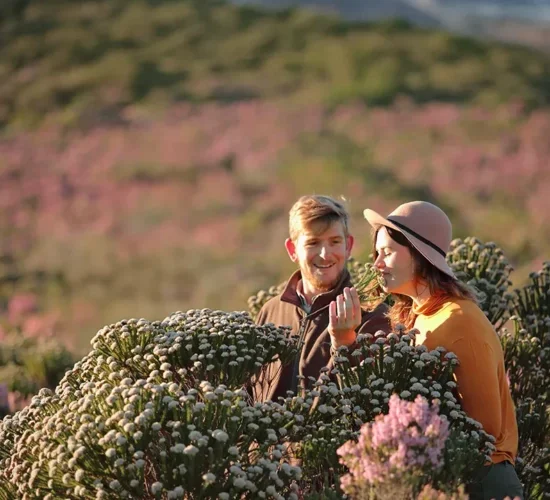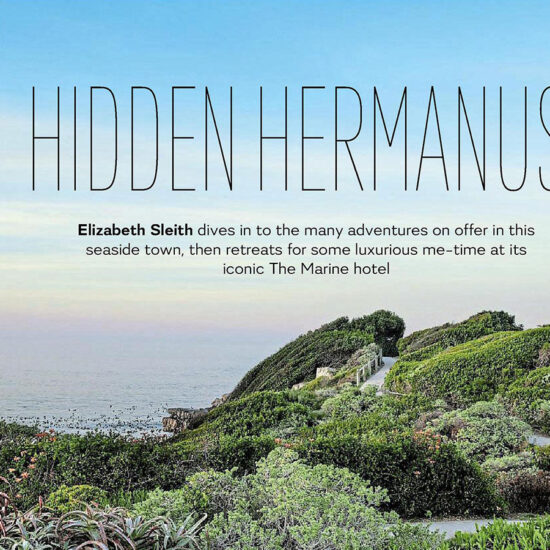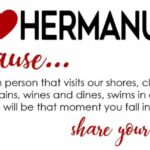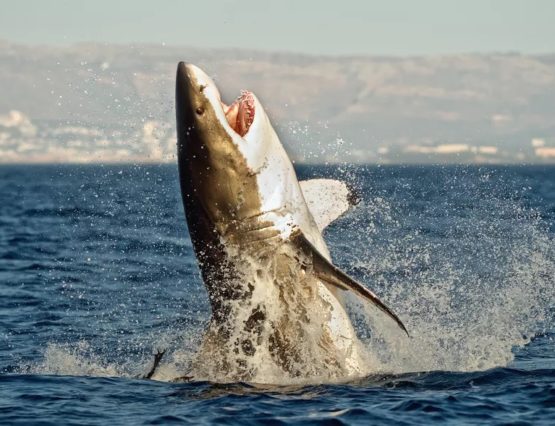
Gansbaai, South Africa: The Complete Guide
Located in the Overberg District of South Africa’s spectacularly beautiful Western Cape province, Gansbaai is a popular tourist destination on the Cape Whale Coast. Although it made its mark in decades past as an important fishing town, it is now famous for its shark diving industry, magnificent fynbos scenery, and excellent farm-to-table cuisine.
Gansbaai’s History
Archaeological evidence found at nearby Klipgat Cave shows that the area around Gansbaai has been inhabited by humans and their ancestors for more than 80,000 years. More recently it was a stronghold for the pastoralist Khoi tribe, and then for white sheep farmers who settled here in the beginning of the 18th century. The first fishing cottages were built in 1811, under the milkwood trees that line the shore of Stanford’s Bay; the settlement was given the name Gansbaai (an Afrikaans word meaning “Bay of Geese”) due to the presence of a fresh water fountain frequented by wild geese.
This early settlement grew into a commercial fishing community with the development of a harbor and whaling station. During the Second World War, prosperity came to Gansbaai as one of its factories processed shark liver for use as a lubricant. With peace came a decline in fortunes, until the foundation of the Gansbaai Fishing Co-Op in 1952. A modern fish meal factory and cannery were built, cementing the town’s status as one of the most important fishing communities in the Western Cape.
Fishing continues to account for a large portion of the town’s income, along with tourism generated by a cage diving industry based on the historic presence of great white sharks in Gansbaai’s waters.
Shark Diving Capital
The establishment of the white shark diving industry earned Gansbaai the title “Shark Diving Capital,” with experts touting it as one of the best places in the world for close encounters with the ocean’s greatest apex predator. White sharks used to be particularly prevalent in the area due to a collection of small islands located just offshore. The largest, named Dyer Island, supports a colony of African penguins, while nearby Geyser Rock boasts a population of approximately 60,000 Cape fur seals.
The number of great whites in the area was therefore explained by an abundance of prey, with the narrow channels between the islands lending themselves well to the sharks’ ambush hunting techniques. However, great white shark sightings have declined almost completely since 2017. There are several theories as to why the predators have disappeared from Gansbaai’s waters, with some experts blaming the phenomenon on orca whale predation and others claiming that poaching, overfishing, and the use of shark nets and drumlines further up the coast are responsible.
Despite the fact that Gansbaai can no longer claim to be the world’s white shark capital, those who book a cage diving trip will not be disappointed. In the years since the white sharks’ disappearance, bronze whaler or copper sharks have taken over their territory; with a maximum length of over 10 feet, they are just as capable of inducing an adrenaline rush when encountered at close quarters. We recommend Marine Dynamics for shark diving, as they guarantee a clean, dry wetsuit for every diver and a marine biologist on every trip. They also run the Dyer Island Conservation Trust.
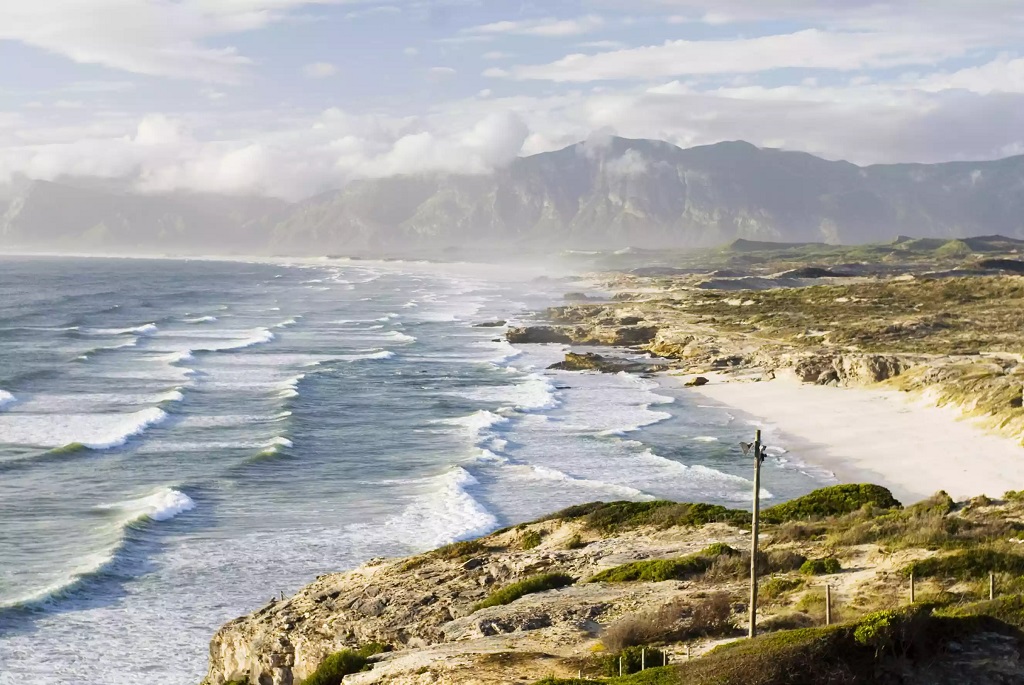
Other Things to Do
Marine Wildlife Tours
Sharks are not the only wildlife attraction in Gansbaai. It was here that the term “Marine Big Five”was coined, with operators like Dyer Island Cruises offering the chance to get out on the water to see sharks, whales, dolphins, penguins, and seals. May to December is peak whale watching season. At this time, southern right whales migrate past the Gansbaai coastline on their journey between the nutrient-rich waters of the Southern Ocean and the warm waters of the Indian Ocean. Many pause en-route to mate and calve in Gansbaai’s Walker Bay, offering great boat and land-based whale watching opportunities.
Gansbaai is also home to the African Penguin and Seabird Sanctuary, a facility for the rescue and rehabilitation of approximately 30 different species of native seabirds. You can visit the rescue center to meet its inhabitants and learn more about the conservation issues affecting the endangered and endemic African penguin. These include habitat loss, overfishing, and oil spills, together resulting in the decline of Dyer Island’s penguin population from 72,500 birds in 1976 to fewer than 1,000 breeding pairs today.
Beaches and Tidal Pools
Visitors to Gansbaai can take their pick of unspoiled beaches. Stanford’s Bay is a secluded cove in the De Kelders area, with a small, white sand beach, rock pools for the kids, and a large grassy area for picnicking and sunbathing. For a longer stretch of sand (ideal for jogging or beach sports), try Franskraal Beach, or drive 20 minutes to Pearly Beach. The latter is one of the longest uninterrupted white sand beaches in the Western Cape, and is especially renowned for whale watching in season. Gansbaai has two tidal pools, too: one at Perlemoenbaai and one at Kleinbaai.
Nature Areas and Outdoor Activities
The area around the town is part of the Cape Floral Region, a UNESCO World Heritage Site that represents the smallest yet most biodiverse of the world’s six Floral Kingdoms. Botanists should look out for more than 9,000 plant species, almost 70 percent of which are endemic. A great way to explore the region’s botanical splendor is to visit the Cape Nature Walker Bay reserve. Here you’ll find scenic hiking trails and 4×4 routes, beaches for angling and swimming, and wildlife such as the endangered African black oystercatcher and the Cape clawless otter.
The privately owned Platbos Forest Trail is another great way to spend a day, as it takes you deep into Africa’s southernmost forest. Amidst ancient trees that are estimated to be over 1,000 years old, you will find a forest labyrinth made from mother-of-pearl sea shells. Other options for outdoor adventure in the surrounding area include Pearly Beach Horse Trails, Gansbaai Golf Club, and a bevy of operators offering everything from kayaking and quad biking to scenic helicopter flights.
Historic Landmarks
If you want to learn more about Gansbaai’s human history, head to Klipgat Cave (part of Cape Nature Walker Bay). Here, a circular boardwalk and signboards explain the evidence of Middle and Late Stone Age human habitation found inside the cave, and their significance for our understanding of our early human ancestors in Africa. Offering an insight into more recent events, the Strandveld Museum at Franskraal Beach uses a fascinating collection of artifacts to describe the lives of mainlanders and the historic headman of Dyer Island.
Also of interest is Danger Point Lighthouse, constructed in 1895 to make the notoriously treacherous coastline safer for passing mariners. More than 140 ships have wrecked off the Gansbaai coast, the most famous of which was the “HMS Birkenhead.” Sunk a mile offshore after running aground on Danger Point in 1845, 445 men lost their lives after allowing all the women and children on board to escape to safety in the lifeboats first—a precedent that later became a globally accepted code of honor. There is a memorial to the “Birkenhead” at the lighthouse.
Where to Eat and Drink
With two harbors yielding fresh catches every day, seafood is inevitably a focus of Gansbaai’s culinary scene. There are several excellent restaurants to choose from, with our favorites being Thyme at Rosemary’s and the Blue Goose. The former serves up traditional South African seafood and game dishes that are prepared using herbs and vegetables from its own organic garden. The Blue Goose also offers a farm-to-table experience, with sustainable and seasonal ingredients complemented by an impressive choice of regional wines by the glass.
If you want to sample these wines at the source, drive 15 minutes out of town to Lomond Winery. Located on the slopes of Ben Lomond mountain, the estate is blessed with the ideal environment for a range of different cultivars, including sauvignon blanc, cabernet sauvignon, merlot, pinot noir, mourvèdre, and viognier. They offer wine tasting experiences and a variety of gourmet platters that highlight the best of the region’s cheese, fish, and meat.
Where to Stay
Gansbaai has plenty of charming bed and breakfasts and guesthouses to choose from. We particularly like Crayfish Lodge, De Kelders B&B, and White Shark Guest House. Crayfish Lodge is a 5-star establishment with stunning views of the Overberg coastline and mountains, a solar-heated swimming pool, spa treatments, and deluxe breakfasts. De Kelders B&B keeps things personal with just four en-suite rooms and a breathtaking location on the shores of Walker Bay (ideal for whale watching in season). White Shark Guest House boasts contemporary African décor and sweeping sea views, and offers the chance to self-cater in the communal kitchen or outdoor braai area.
Best Time to Go
South Africa’s winter and summer seasons are opposite to those in the Northern Hemisphere; June to August is the coldest period while December, January, and February are characterized by hot weather, little wind, and blue skies. Summer is therefore the best time to visit if you plan on hiking or enjoying the beach. However, winter offers the best underwater visibility and is therefore the optimum time for shark diving. Additionally, while sharks can be seen all year round, June to September offers the highest chance of great white sightings. May to December is whale migration season.
Getting There
Gansbaai is approximately 115 miles from Cape Town and 27 miles from the popular whale-watching town on the other side of Walker Bay, Hermanus. The quickest route from Cape Town takes two hours and 15 minutes by car; head southeast along the N2 highway, then onto the R316 at Caledon before turning southwest to Gansbaai at the junction of the R326. Marine Dynamics also offers transfers from Cape Town to Gansbaai via shuttle bus, luxury vehicle, or helicopter.
The R326 and N2 in the opposite direction connects the town with the Garden Route and the rest of South Africa’s east coast. If you’re traveling from Hermanus, take the R43 heading east out of town all the way to Gansbaai. This journey takes roughly 45 minutes.
Sorry, the comment form is closed at this time.

